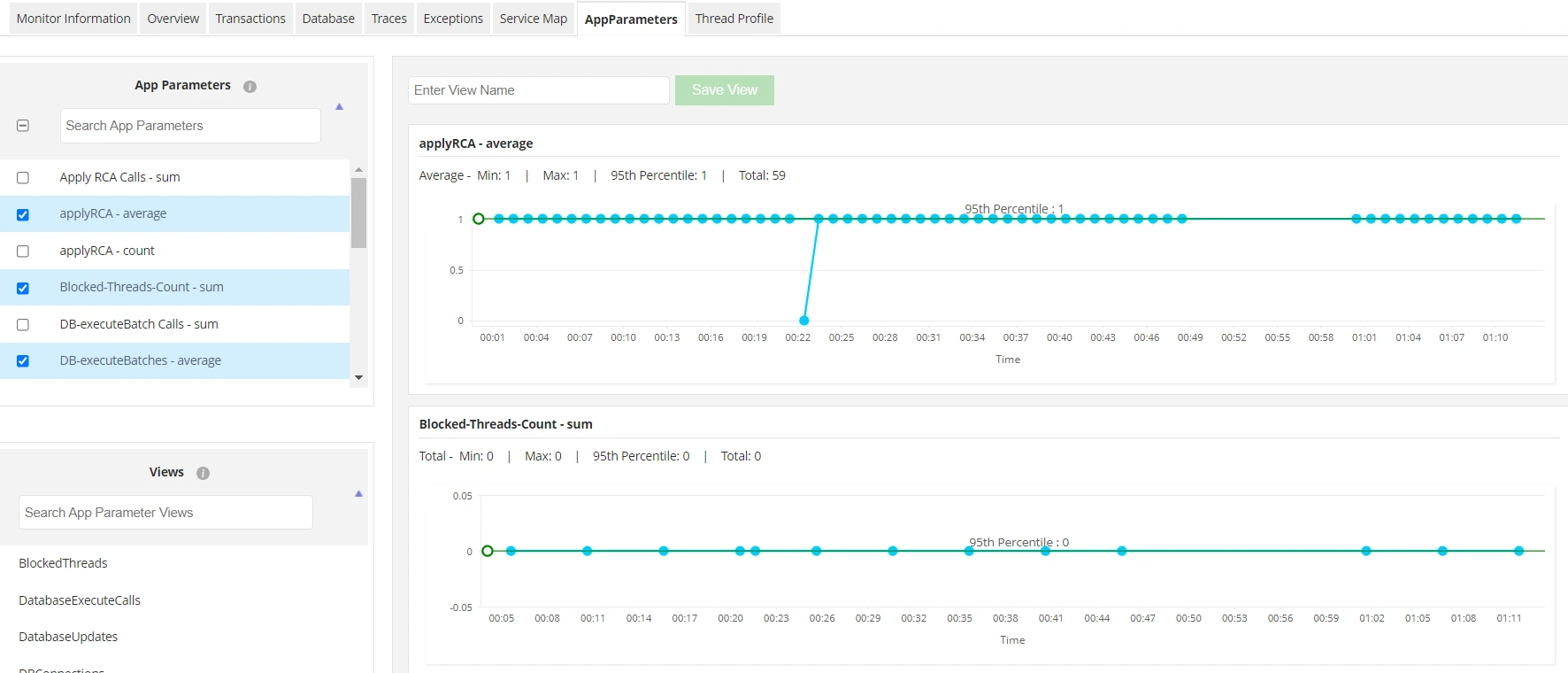Application performance management (APM) for enterprises
Ditch the black box and take control of your application performance with Applications Manager's suite of Enterprise application performance management tools, a comprehensive solution for monitoring, diagnosing, and optimizing application performance. Obtain deep visibility into user interactions with your distributed applications, identify bugs in your code, and resolve problems before they impact users with AI-powered anomaly detection.
Here's how Applications Manager can work for the different stakeholders in your organization:
- DevOps teams Streamline release cycles and reduce time to resolution with instant incident alerts and root cause analysis. Proactive monitoring ensures your applications remain resilient and dependable.
- Site Reliability Engineers (SREs) Ensure exceptional user experience by proactively identifying and resolving issues before they impact customers. Secure your applications and build trust with robust monitoring practices.
- Product Owners Make data-driven decisions about your applications based on real-time performance metrics. Prioritize features and enhancements that deliver maximum value to your customers.
- Cloud Ops Optimize your cloud infrastructure and reduce costs with granular insights into resource utilization. Applications Manager seamlessly integrates with leading cloud platforms for unparalleled visibility and control.
- IT Operations Gain real-time visibility into infrastructure health and performance. Automate repetitive tasks and focus on strategic initiatives that drive innovation.
Dive deep into every aspect of your applications:
- Leave no stone unturned: Monitor every facet of your business applications, from servers and databases to networks and user interactions. Gain a holistic view of performance and identify bottlenecks hindering your application's full potential.
- Measure the impact of every component: Understand how individual components contribute to overall performance. Pinpoint inefficiencies and optimize resource allocation for maximum impact.
- Gauge the user's experience:Monitor user activity metrics like session duration, page views, and clicks to understand user engagement levels. Measure user satisfaction levels with Apdex scores.
- Reduce MTTR and MTTI: Accurate error identification is crucial for rapid incident resolution, optimizing application performance, and delivering exceptional user experiences. Applications Manager's advanced diagnostic tools help you pinpoint issues with laser precision, ensuring flawless application performance.
- Pinpoint errors and exceptions: Unmask the culprits behind unexpected application crashes and cryptic errors. Get information on the errors and exceptions thrown during application operation.
Explore the power of Applications Manager's application performance management in this quick video

Orchestrating a performance harmony between IT teams with application performance management
DevOps, Digital experience, and Server & Infrastructure – often siloed, but with critical interdependence. Applications Manager breaks down these barriers with its comprehensive application performance management tool. It empowers DevOps teams to optimize code, prevent bottlenecks, and accelerate deployments. Ensure flawless user experience with real-time insights and proactive performance management. Applications Manager seamlessly bridges the gap between teams, driving a smooth application lifecycle, increased user satisfaction, and reduced operational costs.
The operations of IT teams can be primarily divided into three:
Application performance management in DevOps
While traditionally focused on production environments, extending application performance monitoring (APM) practices to the development phase offers significant advantages. Early integration of application performance management within the DevOps toolchain unlocks actionable insights that propel application performance and stability, while simultaneously reducing development time. This proactive approach aligns with DevOps best practices, empowering teams to iterate faster, deliver higher-quality applications, and optimize resource utilization.
By working in tandem with existing application performance management systems, this DevOps monitoring strategy strengthens the entire DevOps and SRE ecosystem, fostering continuous improvement across testing, management, security, and CI/CD pipelines. As IT demands evolve, integrating application performance monitoring solutions throughout the development lifecycle ensures businesses remain agile, responsive, and ready to deliver exceptional digital experiences.

Embrace the future of DevOps with Applications Manager's comprehensive application performance monitoring solution. Eliminate the persistent delays and performance bottlenecks that impede your DevOps workflow. Imagine slashing development time by 20%, eliminating frustrating bugs, and building a reputation for unwavering performance.
With Applications Manager's application performance management tool, DevOps teams can:- Pinpoint performance regressions introduced by new code with laser precision, ensuring seamless application upgrades and minimal disruption.
- Identify and address potential bottlenecks in database queries, API calls, or memory usage before they impact user experience or operational costs.
- Equip AppDev teams with actionable performance data and detailed code-level insights, enabling them to optimize code and deliver high-performing applications.
- Collaboratively build a culture of performance excellence through shared application performance management dashboards, real-time alerts, and data-driven decision-making.
- Annotate infrastructure upgrades, version updates and system changes with Milestone Marker and understand how the new elements are affecting overall IT performance.
Monitor application performance to measure end user experience
Frustrated by reactive troubleshooting and unpredictable performance during peak hours? IT Ops and DevOps
teams share a common goal: keeping customers happy and generating revenue. But how
can you ensure your applications can handle the pressure before it impacts users?
By appending an end user experience monitoring (EUEM)
strategy to your existing performance monitoring, of course. It is a fantastic way to gain a holistic view of
how your applications are performing from the user's perspective. Often, traditional applicaton performance management metrics might not reveal issues that impact user experience directly. End user monitoring digs deeper, tracking user journeys, response times, and resource consumption from the user's standpoint, pinpointing hidden
bottlenecks that traditional monitoring might miss.
By understanding how users interact with your applications, you can proactively address potential issues
before they impact user experience. This translates to fewer frustrated customers, better brand reputation,
and potentially decreased customer defection.

Applications Manager offers digital experience monitoring along with app performance management, the synergy of which boosts your optimization efforts and maximizes return of investments(ROI). The suite of digital experience monitoring solutions features real user monitoring (RUM), synthetic monitor, webpage analyzer, and a brand reputation monitor. In particular, synthetic monitoring acts like a virtual user, mimicking real-world interactions and proactively identifying potential bottlenecks before they become real customer problems. By preventing downtime and delivering consistent performance, you'll boost user satisfaction, drive loyalty, and watch your revenue soar.
Benefits of the APM+EUEM strategy
Including EUEM in your application performance management strategy shifts the focus from technical metrics to real-world user experience. It enables you to:
- Test and monitor application performance before its launch.
- Preempt performance issues before the end users notice.
- Assess real-user loads and scale your bandwidth accordingly.
- Measure the impact of third party components in your application.
- Get performance stats for application access across geographies, ISPs, devices and more.
Application performance management for IT Operations teams
To ensure infrastructure and operational environments that support application deployments are in order, employing application performance management solutions like Applications Manager is pivotal in maintaining a continuous and smooth flow of operations. This proactive application performance management tool delivers real-time insights, proactive alerts, and root cause analysis, empowering IT Ops to guarantee service level agreements, minimize downtime, and deliver exceptional user experiences. By comprehensively monitoring resource usage, network stats, and server uptime, Applications Manager empowers you to:
- Plan capacity precisely: Accurately predict resource requirements and allocate resources efficiently, minimizing over-provisioning and ensuring optimal resource utilization.
- Optimize performance: Gain granular insights into server and network performance, enabling you to identify and address bottlenecks, proactively prevent issues, and deliver optimal application performance.
- Maintain operational excellence: Achieve consistent uptime and stability by proactively monitoring critical infrastructure metrics and receiving timely alerts for potential disruptions.

While ad hoc scripts offer rudimentary performance insights, their limitations hinder a holistic understanding of application health. Full-stack application performance management software like Applications Manager transcends mere snapshots by providing multi-dimensional, real-time monitoring. It delves deep into application performance, illuminating hidden correlations and uncovering root causes of potential issues. This granular level of monitoring, akin to a detailed architectural blueprint, forms the bedrock of robust performance management practices.
Here's how our comprehensive application performance management software empowers IT Ops teams:
- Holistic monitoring: Get insights into every component of the IT infrastructure—from server, to database, to cloud native.
- Dependency mapping: Understand how applications use the infrastructure and where performance slowness arises.
- Trend forecasting and predictive analytics: Proactively anticipate potential performance issues and proactively address them before they materialize.
- Automated workflows and intelligent alerting: Triage problems quickly and meet SLAs. Reduce false alarms and perform more accurate root cause analysis. Minimize manual workload and ensure timely notification of critical performance anomalies.
Why Applications Manager is one of the best Application Performance Management tool?
Thousands of admins across industries trust ManageEngine Applications Manager for a reason. This comprehensive solution offers out-of-the-box monitoring for over 150 popular servers and business applications, simplifying setup and accelerating insights. Through its unified console, Applications Manager's application performance management solution delivers deep visibility into IT infrastructure health, web application performance, and end-user experience. Proactive alerts and real-time analytics enable IT teams to identify and address performance bottlenecks before they impact business operations. Developers and AppDev teams benefit from actionable data and collaborative capabilities, optimizing resource utilization and enhancing application performance. Ultimately, ManageEngine Applications Manager delivers tangible ROI by streamlining operations, improving user experience, and driving digital transformation.
Start your application performance management process in minutes!
Download our 30-day free trial to experience our application performance management software first hand or schedule a demo call for a personalized touch.

